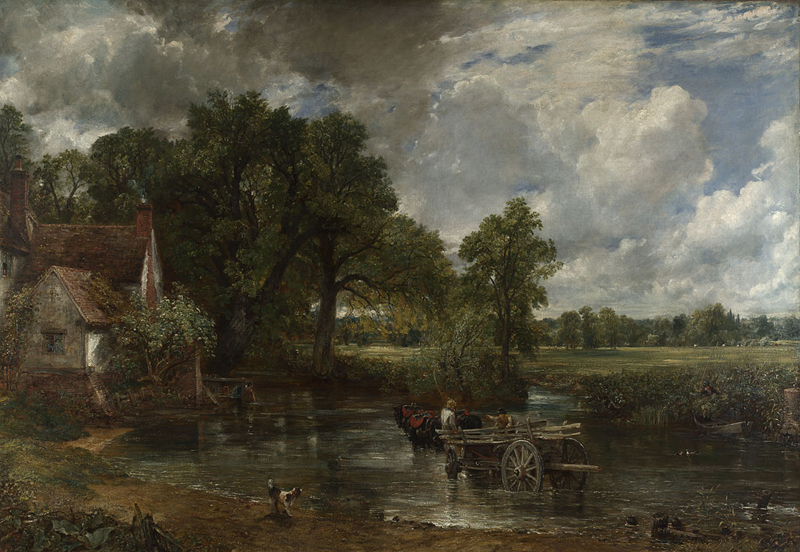The Hay Wain (Landscape noon)
An empty wagon (wain) making its way through the shallow water to cross over to the meadow on the other side where haymakers are at work.
Constable created six River Stour scenes for his ‘Landscape’ exhibits, known as the ‘six-footers’ and exhibited at the Royal Academy.
- 47
- 1821
- 130.2cm x 185.4cm
- National Gallery
- Oil on Canvas
- 160
- Oil on Canvas, 1821, 130.2cm x 185.4cm, National Gallery
- Flatford
- Famous
- 51.95874,1.02160
Details
Created in the artist’s studio in London and working from a number of open-air sketches made over several years, Constable then made a full size oil sketch to establish the composition prior to painting this final picture.
It is uncertain how it acquired the name ‘Haywain’ but it is referred to by this name in a letter sent to his friend John Fisher not long before the painting was moved from the Keppel Street painting room to the Academy. ‘The present picture is not so grand as Tinny’s (referring to ‘Stratford Mill’ owned by J.P.Tinney) owing perhaps to the masses not being so impressive – the power of the Chiaro Oscuro is lessened – but it has rather a more novel look than I expected. I have yet much to do it – and I calculate for 3 or 4 days there’
Other ‘six-footers’ from the Royal Academy exhibition, all from The River Stour at Flatford, were ‘The White Horse’ 1819, ‘View on the Stour near Dedham’1822, ‘The Lock’ 1824, ‘Leaping Horse’ 1825, and the sixth being further up stream at Stratford ‘Stratford Mill’ 1820.Originally titled ‘Landscape noon’ as Constable sketched the scene every day at noon, it was bought by French dealer John Arrowsmith along with 3 other sketches that went on to be exhibited at the Paris Salon of 1824 winning a gold medal and gaining the attention of the younger artists of the time moving them away from formalism to draw directly from nature. During the French Revolution many painters gathered at ‘Barbizon’ to follow Constable’s ideas and French landscape became a major theme to the ‘Barbizon’ school, which over the years included many well known artists such as Claude Monet, Pierre-Auguste Renoir, Alfred Sisley, and even post impressionist painter Vincent Van Gogh.
The inhabitants of the town even today are called ‘Barbizonais’, the school is still active and owes its fame to the 19th century landscape painters.
Barbizon has been ‘twinned’ with East Bergholt for over 40 years.
Presented to the National Gallery by Henry Vaughan in 1886
- 47
- 1821
- 130.2cm x 185.4cm
- National Gallery
- Oil on Canvas
- 160
- Oil on Canvas, 1821, 130.2cm x 185.4cm, National Gallery
- Flatford
- Famous
- 51.95874,1.02160

